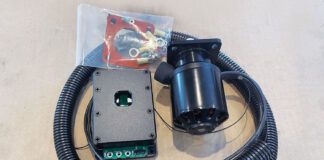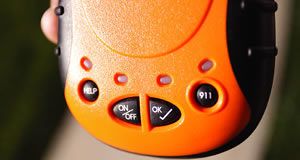I said in a prior issue that I’d give you a column on anything that you asked of me. This column on electrical multimeters was asked for by two of you, so here we go.
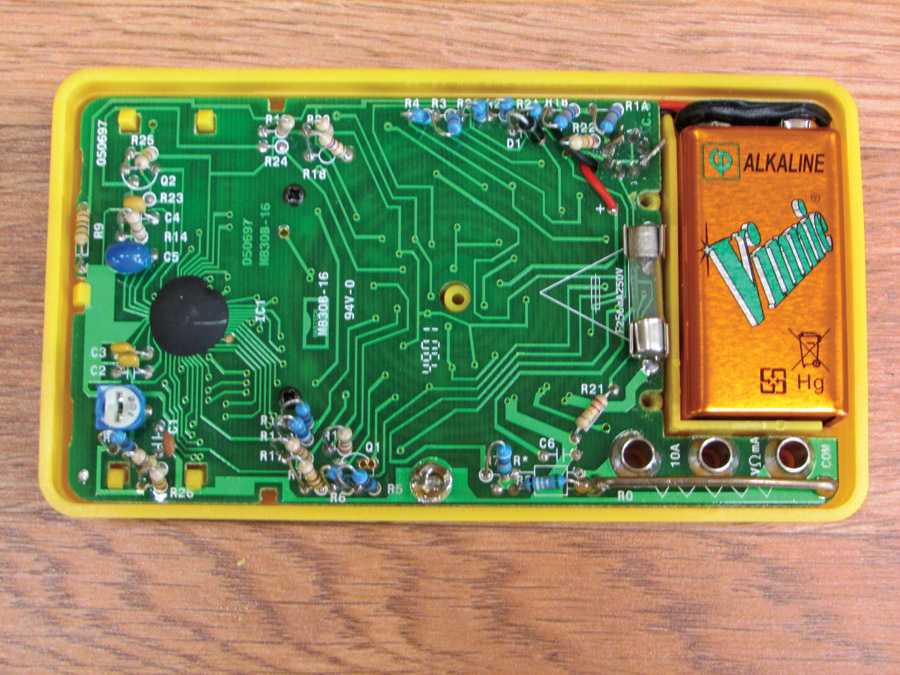
The inside of a digital multimeter. The unit is powered by a 9-volt battery. The little glass tube with metal end caps just to the left of the battery is the milliammeter fuse. I suggest you buy half a dozen of them when you are first learning your multimeter.
I am offended by the book series This ‘n That for Dummies. We aren’t dummies. We build complex airplanes. Darwin crashed the dummies that build airplanes a long time ago, and that keeps them from passing their dummy genes on to a new crop of dummies. We and our kids are a pretty smart bunch of folks. But just because we know how to warp a wing or rivet a rudder doesn’t mean we know how to use an electronic meter. That isn’t dummy, that’s just a gap in knowledge. Your electronic gap-filler articles are about to fill that cavity.
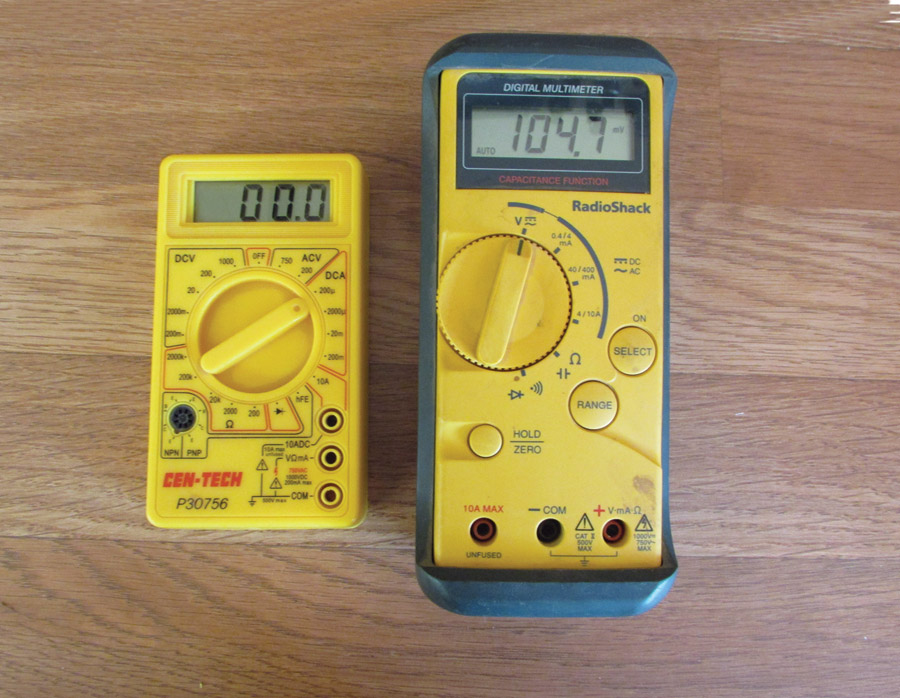
Integrated circuits and inexpensive digital displays have made the multimeter really quite simple to use. I do have a recommendation…the unit on the left is a cheap Harbor Freight $5 meter that breaks quite easily. Go through a couple of these before you spring for the $100 unit on the right that will be in your toolbox for the rest of your career.
We have three electrical quantities that we need to talk about today. We need to talk about voltage, current, and resistance. In electronic speak, we let the letters E (voltage, or electromotive force), I (current), and R (resistance) stand for these quantities.
Let’s talk about each one briefly:
• E — voltage, is the pressure of the electricity. Just like with an oil pump, you can produce a lot of pressure but if the output of the pump is capped, nothing happens—just a lot of pressure in the pump with nowhere to go.
• I — current, is the amount of electricity that is flowing in the system. Again, to use the oil pump analogy, that is the quarts per minute of oil that is flowing out of the pump, through your engine, back into your sump, back to the pump.
• R — resistance, is the restriction to unlimited electrical flow. What restricts the unlimited flow of oil? Crankshaft bearing clearance? Small orifices to tappets and other low-flow oil parts? Little tiny oil lines?
So, here is the electronic dance…the electrical power system (battery and generator) supply a constant (“E”) voltage up to a point, say 12 volts for discussion. A device (radio, starter, landing light) with a known resistance (“R”) is connected to the voltage. A current (“I”) will flow to make that device work. You hook up a 2 ohm landing light to a 12 volt battery and 6 amperes of current will flow—guaranteed, along with bright light.
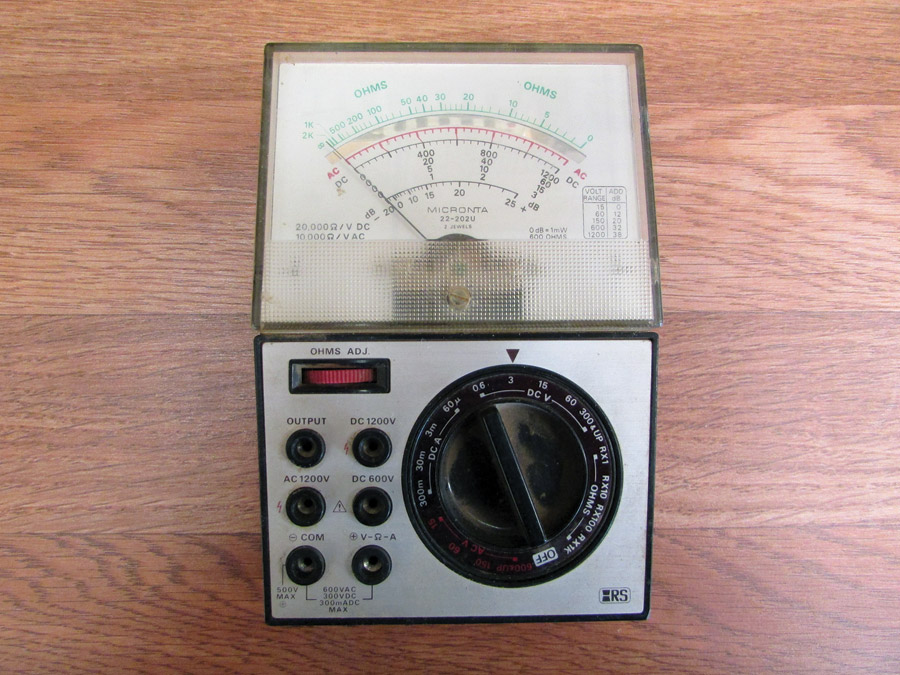
An ancient (50+ years old) analog multimeter. This is the reason that the multimeter has a bad reputation. It takes me 10 minutes to remember what all those scales mean.
A couple of centuries ago, a pretty smart fellow from the University of Munich named G. S. Ohm said that the relationship of voltage to current in a circuit was the resistance. Forgive me for those of you who still tremble remembering Mr. Snidely’s sophomore Algebra I class, but we express it mathematically as an algebraic equation: R = E/I. According to Ohm then, when you divide the voltage by the current, you come up with a resistance. Again, with a nod to Mr. Snidely’s algebra, we can rewrite this Ohm’s law equation to say not only does R=E/I, but I=E/R and E= I*R. What this means is that given any two of the electrical values, we can calculate the third one just like I calculated current in the last paragraph about the landing light.
A few hundred years ago when we first started messing with this electrical stuff, a smart fellow named Oersted found that if he wrapped a few turns of wire around a compass and passed some current through the wire, the compass needle would deflect, and the more the current the more the deflection. Amazing. There is some sort of connection between electricity and magnetism and the first ampere-meter, or ammeter was born.

The best thing that happened to multimeters in 1955 or so—a meter using vacuum tubes for the measurement. This increased ease of use by a factor of 100 or so. It was called a VTVM for vacuum tube voltmeter, but it should have been a VTMM for vacuum tube multimeter.
(Just as an aside, any one of you who can completely explain the connection between electricity and magnetism is in line for next year’s Nobel Prize…Einstein couldn’t exactly explain it.)
So, the first meter that was invented was the current-measuring ammeter. Let’s talk about this current-measuring part of the multiple-meter, or as it is more commonly called, the multimeter. (And for abbreviations, from now on, this is the “MM.”)
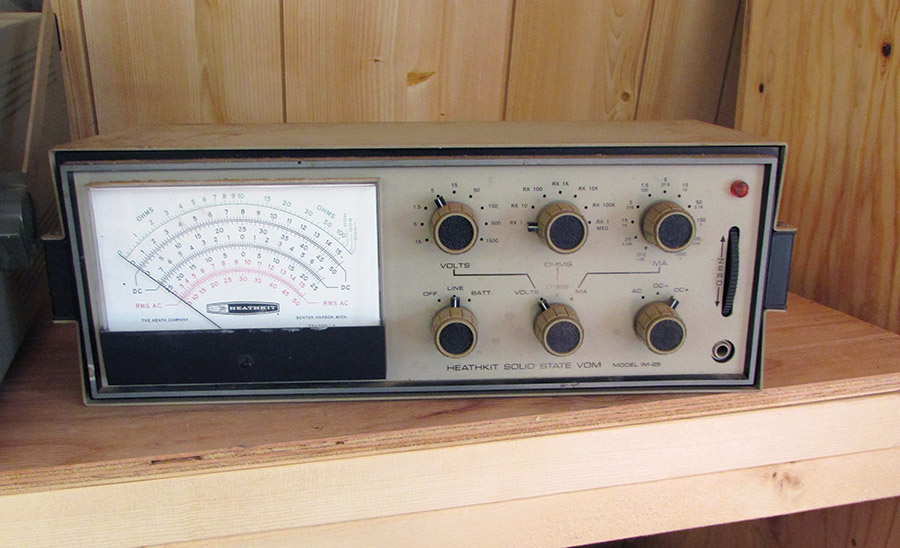
Vacuum tubes became obsolete and the transistor took over in 1970 or so. This particular one has been my everyday bench go-to for 35+ years and is as accurate today as the day I bought it.
Truly, we could have a single meter that measures nothing but current. Indeed we do have such an instrument in the airplane, and we call it an ammeter. Some of us have installed a dual volt-ammeter in the airplane. You have in fact installed a multimeter (MM) into the airplane.
Now that we’ve laid the foundation for measuring voltage, current, and resistance, let’s see a short history of how we’ve tried to measure it.
Somewhere around 1900 we invented the multimeter. The one in the photo is an old-timer that has a “50KΩ per volt sensitivity.” We’ll talk about that later.

Measuring across the open-circuit switch on a little flashlight. Note that the current through the LED is 58.4 milliamperes (mils).
Let’s move forward 50 years. We found that we could use vacuum tubes to increase the sensitivity of our MM by over a hundredfold. We called it a Vacuum Tube Volt Meter (VTVM).
Twenty years later, we found that we could use transistors to do the same job as vacuum tubes, and we called it a “solid-state” Volt-Ohmmeter (VOM).
The next image shows that today we can use integrated circuits and mass production to bring the price down by a factor of 10:1 and have digital readout instead of analog (pointer-type) meters.
Since the current meter is the granddaddy of the three meters, let’s start here:
Current Meter Rules
• Current is measured in amperes. In electronics, it is more common to measure in 1/1000 (one-thousandth) of an ampere, commonly called a milliampere, abbreviated mA. It is quite common in a delicate circuit to measure in 1/1,000,000 (one-millionth) of an ampere, commonly called a microampere, abbreviated uA, or more formally μA. Colloquially we sometimes take shortcuts and talk about “mils” and “mikes” as verbal abbreviations.
• Current meters (“ampere-meters” or more commonly “ammeters”) measure in series with the circuit being measured. Trying to measure current by putting the meter across the circuit in parallel will usually result in a blown fuse inside the meter. One trick worth mentioning is that if you want to measure the total current of a circuit, you can measure across the on/off switch in the open (“off”) position, or a pulled circuit breaker, or a fuse holder with the fuse removed.
• If we are not sure of our circuit and can’t take a good guess at what the current might be, we start with the highest scale on the meter (in this case, 200 mA) and then go down in current to get the most accurate reading. In the example shown, where we are measuring the current of this little flashlight, we can see that we are measuring on the 200 mA scale and that the current is 58.4 “mils.”
• All ammeters have some low internal resistance that will cause a small voltage drop during the measuring process. In the case of the little Harbor Freight multimeter, the manual says that the drop is about 200 millivolts (0.2 volts).
• Most multimeters have a “large amps” connection that will measure a few amperes. The HF meter we are using has a 10-amp port with one caution…it is not fused. Trying to measure, for example, a starter current in the dozens to low hundreds of amps will trash the meter.
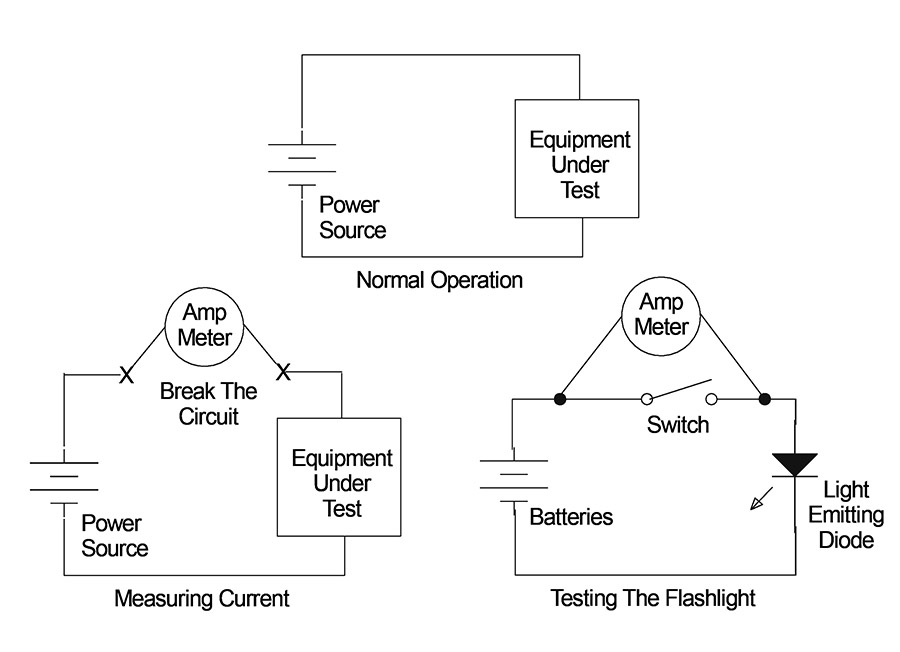
The drawing on the left shows equipment to be tested in normal operation. The center drawing shows how the amp meter breaks the circuit. On the right is the amp meter testing a flashlight.
That about does it for the “amps” section of the multimeter. In upcoming issues we will take a look at voltage, resistance, and those other “goofy” things that just make for confusion.
Isn’t that a pretty test bench that the solid-state VOM meter is on? We’ll talk about the ultimate electronics test bench next month. Until then, stay tuned…

![]()
Jim Weir is the chief avioniker at RST Engineering. He answers avionics questions in the Internet newsgroup www.pilotsofamerica.com-Maintenance. His technical advisor, Cyndi Weir, got her Masters degree in English and Journalism and keeps Jim on the straight and narrow. Check out their web site at www.rst-engr.com/kitplanes for previous articles and supplements.










